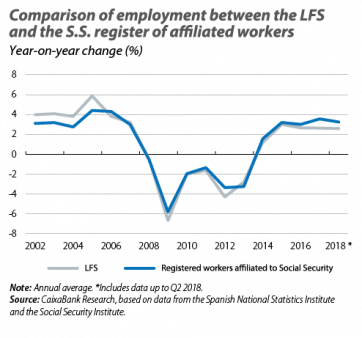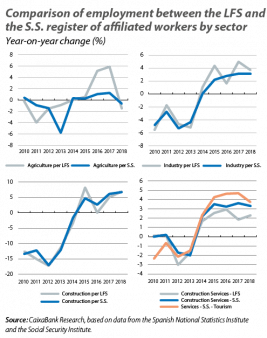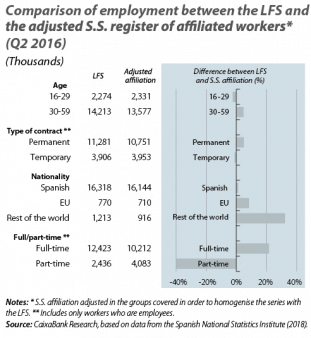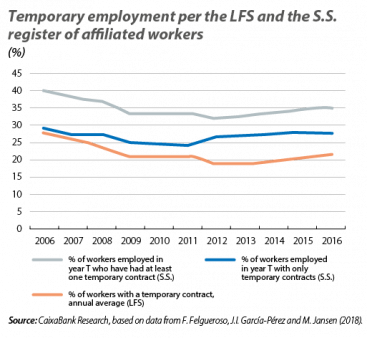The labour market in Spain - does it all depend on the colour of the glass you’re looking through?
The main sources of information we have for monitoring the progress of the labour market appear to be sending us conflicting signals. According to the labour force survey (LFS), in Q2 the rate of job creation accelerated to 2.8% (2.4% in Q1). In fact, according to the LFS, this quarter marked a historic milestone in terms of job creation: never before had so many jobs been created in the second quarter (470,000). On the other hand, if we analyse the number of registered workers affiliated to Social Security (S.S.), we observe that its rate of growth slowed slightly, falling from 3.4% in Q1 to 3.1% in Q2. What causes these differences? Is one source more reliable than the other?
The reader has probably already guessed the answer that an economist will give them: it depends. Specifically, it depends on what question you are trying to answer. The LFS and affiliation to S.S. are the two main sources of information on the labour market in Spain and, to a large extent, offer us complementary information. On the one hand, the LFS is a quarterly survey that provides detailed information on the labour situation and the characteristics of the working age population. An important aspect of the LFS is that it considers a person to be employed if they have worked during the week in which the survey is carried out, regardless of whether they have worked in the formal or informal economy. Affiliation to S.S., meanwhile, is an administrative register which records, on a daily basis, all workers who are registered as being in employment.1
So, if the question is, for example, what is the percentage of the population in employment or unemployment (the activity rate), the LFS offers a specific figure that is comparable between countries. If, on the other hand, the question is regarding how many people obtain or lose work on a particular day, the S.S. affiliation data offer a precise answer,2 since they contain information regarding the situation of all workers registered as being in work over time. However, this series does not provide information on the rest of the labour force (people who are not registered) and, unlike the LFS data, it does not provide detailed information on the characteristics of the individuals (age, sex, educational level, etc.). Furthermore, the series of affiliation to S.S. is subject to legislative changes over time, making it difficult to build homogeneous time series that are comparable between countries.
Let us revisit the recent data on the progress of the labour market. Broadly speaking, the number of registered workers affiliated with S.S. reflects a lower number of workers than the LFS, but a higher rate of job creation. Specifically, in Q2 2018 there were 18.9 million registered workers affiliated to S.S., while per the LFS the number of employees was slightly higher, at 19.3 million. However, over the last five years of recovery, the number of people employed has grown by an average of 3.3% year-on-year, according to the data of registered workers affiliated with S.S., while according to the LFS this figure is +2.8%.
When we analyse the situation by sector, the differences are even more pronounced. In agriculture, there are more employees according to the S.S. data than according to the LFS (1.2 million employees versus 0.8 million). This is partly due to the fact that many people remain registered under the agricultural S.S. scheme during the periods in which they are not actually working. In all other sectors, we observe a greater number of employees per the LFS than per the S.S. data, but the rate of job creation has been higher according to the S.S. data than the LFS data. This could be associated with an increase in formal employment.3 In the last two years, for example, S.S. affiliation increased in the services sector by 3.4% year-on-year, 1 pp more than per the LFS.
Another factor that can explain the differences between the two series is that the corresponding sources of information cover different populations. In this regard, the Spanish National Statistics Institute produces a homogenised series of the number of registered workers affiliated to S.S., in order to make it more comparable with that of the LFS. Despite this, discrepancies persist in the employment figures observed (see the third chart). Of particular note, for instance, are the differences in the number of employees by nationality. While the number of employees in Spain is very similar between the homogenised series, this is not the case among foreigners: the LFS reflects 8% more foreigners from the EU being employed and 32% more from the rest of the world than the S.S. affiliation data. On the other hand, the LFS estimates that the number of young employees (16-29) is lower than that observed in the S.S. affiliation data. This is also the case with the figures for workers with a part-time or temporary contract.
With regard to the rate of temporary employment, the LFS shows us that Spain has the highest rate in the EU (26.2% in Q1, 12.3 pps above the EU average). However, the LFS may be overstating this rate of temporary employment, since it does not include employment of a very short duration which occurs outside of the week in which the survey is conducted. The S.S. affiliation data, on the other hand, does take this type of employment into account, and they show a higher rate of temporary employment, with around 35% of employees having at least one temporary position of employment in 2016, according to Felgueroso, García-Pérez and Jansen (2018).4 Furthermore, according to another indicator, namely the proportion of employees with only temporary contracts during the year, the S.S. affiliation data reveals how workers now need to have more temporary contracts before being offered a permanent job.
In short, both the LFS and the S.S. register of affiliated workers show a strong rate of job creation throughout the recovery and, furthermore, they both point out that a high rate of temporary employment still persists. Nevertheless, we have also seen that, due to their methodological differences, in order to perform a credible analysis of the status of the Spanish labour market, we have to use them in a complementary manner.
1. The figures for registered workers affiliated to S.S. do not include public sector workers of some mutual societies (MUFACE, etc.), household employees who work less than 20 hours a week, or people performing sporadic work to assist in a family business. The LFS, meanwhile, does not consider as being employed those who make social security contributions but do not work, as sometimes occurs in the agricultural sector or in the case of workers who are temporarily suspended due to a collective dismissal.
2. On 31 August 2018, 58,375 workers registered with S.S., while 363,017 cancelled their affiliation, resulting in a significant net decrease (–304,642) on that day, a Friday at the end of the month and quarter.
3. Traditionally, the black economy plays a greater role in these sectors of the economy, as shown by F. Schneider (2013) in «The Shadow Economy in Europe, 2013», A.T. Kearney and Visa.
4. F. Felgueroso, J.I. García-Pérez and M. Jansen (2018), La contratación temporal en España: nuevas tendencias, nuevos retos in «Los problemas del mercado de trabajo y las reformas pendientes», Papeles de Economía Española n.º 156.







